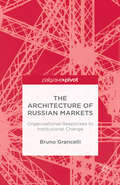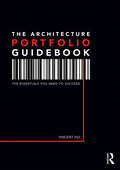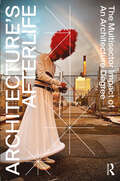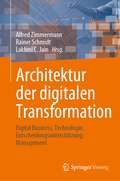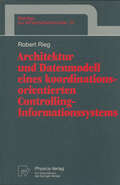- Table View
- List View
The Architecture of Markets: An Economic Sociology of Twenty-First-Century Capitalist Societies (pdf)
by Neil FligsteinMarket societies have created more wealth, and more opportunities for more people, than any other system of social organization in history. Yet we still have a rudimentary understanding of how markets themselves are social constructions that require extensive institutional support. This groundbreaking work seeks to fill this gap, to make sense of modern capitalism by developing a sociological theory of market institutions. Addressing the unruly dynamism that capitalism brings with it, leading sociologist Neil Fligstein argues that the basic drift of any one market and its actors, even allowing for competition, is toward stabilization. The Architecture of Markets represents a major and timely step beyond recent, largely empirical studies that oppose the neoclassical model of perfect competition but provide sparse theory toward a coherent economic sociology. Fligstein offers this theory. With it he interprets not just globalization and the information economy, but developments more specific to American capitalism in the past two decades--among them, the 1980s merger movement. He makes new inroads into the ''theory of fields,'' which links the formation of markets and firms to the problems of stability. His political-cultural approach explains why governments remain crucial to markets and why so many national variations of capitalism endure. States help make stable markets possible by, for example, establishing the rule of law and adjudicating the class struggle. State-building and market-building go hand in hand. Fligstein shows that market actors depend mightily upon governments and the members of society for the social conditions that produce wealth. He demonstrates that systems favoring more social justice and redistribution can yield stable markets and economic growth as readily as less egalitarian systems. This book will surely join the classics on capitalism. Economists, sociologists, policymakers, and all those interested in what makes markets function as they do will read it for many years to come.
The Architecture of Natural Cooling
by Brian Ford Rosa Schiano-Phan Juan A. VallejoOverheating in buildings is commonplace. This book describes how we can keep cool without conventional air-conditioning: improving comfort and productivity while reducing energy costs and carbon emissions. It provides architects, engineers and policy makers with a ‘how-to’ guide to the application of natural cooling in new and existing buildings. It demonstrates, through reference to numerous examples, that natural cooling is viable in most climates around the world. This completely revised and expanded second edition includes: An overview of natural cooling past and present. Guidance on the principles and strategies that can be adopted. A review of the applicability of different strategies. Explanation of simplified tools for performance assessment. A review of components and controls. A detailed evaluation of case studies from the USA, Europe, India and China. This book is not just for the technical specialist, as it also provides a general grounding in how to avoid or minimise air-conditioning. Importantly, it demonstrates that understanding our environment, rather than fighting it, will help us to live sustainably in our rapidly warming world.
The Architecture of Natural Cooling
by Brian Ford Rosa Schiano-Phan Juan A. VallejoOverheating in buildings is commonplace. This book describes how we can keep cool without conventional air-conditioning: improving comfort and productivity while reducing energy costs and carbon emissions. It provides architects, engineers and policy makers with a ‘how-to’ guide to the application of natural cooling in new and existing buildings. It demonstrates, through reference to numerous examples, that natural cooling is viable in most climates around the world. This completely revised and expanded second edition includes: An overview of natural cooling past and present. Guidance on the principles and strategies that can be adopted. A review of the applicability of different strategies. Explanation of simplified tools for performance assessment. A review of components and controls. A detailed evaluation of case studies from the USA, Europe, India and China. This book is not just for the technical specialist, as it also provides a general grounding in how to avoid or minimise air-conditioning. Importantly, it demonstrates that understanding our environment, rather than fighting it, will help us to live sustainably in our rapidly warming world.
The Architecture of Policy Transfer: Ideas, Institutions and Networks in Transnational Policymaking (Studies in the Political Economy of Public Policy)
by Tim LegrandThis book investigates the increasing circulation and transfer of public policy ideas between the UK, US and Australia since the 1990s. It argues that the upsurge in policy transfer amongst and between these states can be explained by a structural and shared commitment between these states to a distinctive institutional ideology of policy-making. This ideology, it is claimed, is partly a product of the historical proximity of ‘Anglosphere’ states, and in recent years can be traced through the evolution of New Public Management principles through to Third Way communitarianism.
Architecture of Regionalism in the Age of Globalization: Peaks and Valleys in the Flat World
by Liane Lefaivre Alexander TzonisThis book remains the definitive introductory text on the theory and history of regionalist architecture in the context of globalization. It addresses issues of identity, diversity, community, inequality, geopolitics, and sustainability. From the authors who coined the concept of Critical Regionalism, this new edition enhances the understanding of the complex evolution of regionalism and its rival, unchecked globalization. Covering a rich selection of the most outstanding examples of design from all over the world, Liane Lefaivre and Alexander Tzonis, who introduced the concept of Critical Regionalism to architecture, present an enlightening, concise historical analysis of the endurance of regionalism and the ceaseless drive for globalization. New case studies include current cutting-edge projects in Japan, Africa, China, and the United States. Architecture of Regionalism in the Age of Globalization offers undergraduate and graduate students of architecture, geography, history, environmental studies, and other related fields an accessible, vivid, and scholarly perspective of this major conflict as it relates to the design and to the future of the human-made environment.
Architecture of Regionalism in the Age of Globalization: Peaks and Valleys in the Flat World
by Liane Lefaivre Alexander TzonisThis book remains the definitive introductory text on the theory and history of regionalist architecture in the context of globalization. It addresses issues of identity, diversity, community, inequality, geopolitics, and sustainability. From the authors who coined the concept of Critical Regionalism, this new edition enhances the understanding of the complex evolution of regionalism and its rival, unchecked globalization. Covering a rich selection of the most outstanding examples of design from all over the world, Liane Lefaivre and Alexander Tzonis, who introduced the concept of Critical Regionalism to architecture, present an enlightening, concise historical analysis of the endurance of regionalism and the ceaseless drive for globalization. New case studies include current cutting-edge projects in Japan, Africa, China, and the United States. Architecture of Regionalism in the Age of Globalization offers undergraduate and graduate students of architecture, geography, history, environmental studies, and other related fields an accessible, vivid, and scholarly perspective of this major conflict as it relates to the design and to the future of the human-made environment.
The Architecture of Russian Markets: Organizational Responses to Institutional Change
by B. GrancelliThis study analyses enterprise development and entrepreneurship and their relationship with the state and market building in Russia. It focuses on continuities and changes in the factory regime, drawing on existing literature and the author's own research and evaluation.
Architecture or Revolution: Emancipatory Critique After Marx
by Nadir LahijiBy linking building theory to the emancipatory project of critique advanced by radical thinkers in our time, this work investigates the key conceptual and historical elements that culminate in an emancipatory theory of building entitled: 'Toward a philosophy of shelter’. Taking Marx as its only resource, this work proceeds with the conviction that our era is contemporaneous to Marx’s historical era. This means ‘not judging the validity of Marx from the perspective of the historical situation’, but rather, ‘demonstrating the validity of a Marxian perspective for a singular historical situation’, as ours. This work will therefore translate this perspective into seeing the situation of architecture through the eyes of Marx. All those concerned with the predicament in our current condition in which architecture must play a major social role in upholding the universal value of what Alain Badiou calls 'generic humanity' will take an interest in this work. In particular, architects, critics, scholars, and students inside the field of architecture who would be seeking the application of this universal value to a new theory of building will be a welcoming audience for this work.
Architecture or Revolution: Emancipatory Critique After Marx
by Nadir LahijiBy linking building theory to the emancipatory project of critique advanced by radical thinkers in our time, this work investigates the key conceptual and historical elements that culminate in an emancipatory theory of building entitled: 'Toward a philosophy of shelter’. Taking Marx as its only resource, this work proceeds with the conviction that our era is contemporaneous to Marx’s historical era. This means ‘not judging the validity of Marx from the perspective of the historical situation’, but rather, ‘demonstrating the validity of a Marxian perspective for a singular historical situation’, as ours. This work will therefore translate this perspective into seeing the situation of architecture through the eyes of Marx. All those concerned with the predicament in our current condition in which architecture must play a major social role in upholding the universal value of what Alain Badiou calls 'generic humanity' will take an interest in this work. In particular, architects, critics, scholars, and students inside the field of architecture who would be seeking the application of this universal value to a new theory of building will be a welcoming audience for this work.
The Architecture Portfolio Guidebook: The Essentials You Need to Succeed
by Vincent HuiThe Architecture Portfolio Guidebook shows you how to make portfolios for both academic and professional needs to provide reviewers exactly what they are looking for. In school, architecture curricula nurture the knowledge and skills to develop design work to varying levels of presentation. In the profession, those skills are further developed and applied in the creation of the built environment. In both contexts, a portfolio is a core component for admission and advancement. This book provides key strategies to: • develop an understanding of the unique needs of professional and academic organizations; • identify applicants’ key differentiators; • highlight how applicants present themselves in their portfolios to address institutional needs; • create successful reinforcing documentation; • communicate using portfolios. Rather than proposing generic solutions, this book details the successful practices for portfolio creation by addressing portfolio creation academically and professionally. Supporting insights and examples from leading academics and architects from around the world reinforce the themes presented in this guidebook. An ideal read for students and professionals of architecture, landscape architecture, interior design, and urban design, looking to advance their studies and careers.
The Architecture Portfolio Guidebook: The Essentials You Need to Succeed
by Vincent HuiThe Architecture Portfolio Guidebook shows you how to make portfolios for both academic and professional needs to provide reviewers exactly what they are looking for. In school, architecture curricula nurture the knowledge and skills to develop design work to varying levels of presentation. In the profession, those skills are further developed and applied in the creation of the built environment. In both contexts, a portfolio is a core component for admission and advancement. This book provides key strategies to: • develop an understanding of the unique needs of professional and academic organizations; • identify applicants’ key differentiators; • highlight how applicants present themselves in their portfolios to address institutional needs; • create successful reinforcing documentation; • communicate using portfolios. Rather than proposing generic solutions, this book details the successful practices for portfolio creation by addressing portfolio creation academically and professionally. Supporting insights and examples from leading academics and architects from around the world reinforce the themes presented in this guidebook. An ideal read for students and professionals of architecture, landscape architecture, interior design, and urban design, looking to advance their studies and careers.
Architecture Principles: The Cornerstones of Enterprise Architecture (The Enterprise Engineering Series)
by Danny Greefhorst Erik ProperEnterprises, from small to large, evolve continuously. As a result, their structures are transformed and extended continuously. Without some means of control, such changes are bound to lead to an overly complex, uncoordinated and heterogeneous environment that is hard to manage and hard to adapt to future changes. Enterprise architecture principles provide a means to direct transformations of enterprises. As a consequence, architecture principles should be seen as the cornerstones of any architecture.In this book, Greefhorst and Proper focus on the role of architecture principles. They provide both a theoretical and a practical perspective on architecture principles. The theoretical perspective involves a brief survey of the general concept of principle as well as an analysis of different flavors of principles. Architecture principles are regarded as a specific class of normative principles that direct the design of an enterprise, from the definition of its business to its supporting IT. The practical perspective on architecture principles is concerned with an approach to the formulation of architecture principles, as well as their actual use in organizations. To illustrate their use in practice, several real-life cases are discussed, an application of architecture principles in TOGAF is included, and a catalogue of example architecture principles is provided.With this broad coverage, the authors target students and researchers specializing in enterprise architecture or business information systems, as well as practitioners who want to understand the foundations underlying their practical daily work.
Architecture's Afterlife: The Multisector Impact of an Architecture Degree
by Michela Barosio Dag Boutsen Andrea Čeko Haydée De Loof Johan De Walsche Santiago Gomes Harriet Harriss Roberta Marcaccio Mia Roth-Čerina Carla Sentieri Neal Sashore Federica Vannucchi Hanne Van ReuselAlmost 40% of architecture graduates choose not to practise as architects. Instead, by ‘leaving’ their chosen profession, this surprisingly large but vastly overlooked cohort are making significant contributions to a wide range of other sectors, from politics to videogame design, demonstrating that architectural training can be a pathway to roles, and even leadership opportunities, across a variety of other professions.Architecture’s Afterlife is the first book to examine the sectors into which these graduates migrate, and to identify the transferable skills that are learned, but not always taught, in their degree programmes, and that prove most useful in their new careers.The book – a result of a three-year pan-European study funded by Erasmus+ – provides a roadmap for increasing graduate employment, addressing skills shortages across all sectors and adapting curricula to changing professional landscapes. It is therefore essential reading for all those responsible for curriculum design and delivery in architecture and other disciplines, including deans, professors, postgraduate researchers and policy makers, as well as students and professionals seeking to expand their career prospects.
Architecture's Afterlife: The Multisector Impact of an Architecture Degree
by Michela Barosio Dag Boutsen Andrea Čeko Haydée De Loof Johan De Walsche Santiago Gomes Harriet Harriss Roberta Marcaccio Mia Roth-Čerina Carla Sentieri Neal Sashore Federica Vannucchi Hanne Van ReuselAlmost 40% of architecture graduates choose not to practise as architects. Instead, by ‘leaving’ their chosen profession, this surprisingly large but vastly overlooked cohort are making significant contributions to a wide range of other sectors, from politics to videogame design, demonstrating that architectural training can be a pathway to roles, and even leadership opportunities, across a variety of other professions.Architecture’s Afterlife is the first book to examine the sectors into which these graduates migrate, and to identify the transferable skills that are learned, but not always taught, in their degree programmes, and that prove most useful in their new careers.The book – a result of a three-year pan-European study funded by Erasmus+ – provides a roadmap for increasing graduate employment, addressing skills shortages across all sectors and adapting curricula to changing professional landscapes. It is therefore essential reading for all those responsible for curriculum design and delivery in architecture and other disciplines, including deans, professors, postgraduate researchers and policy makers, as well as students and professionals seeking to expand their career prospects.
Architecture’s Disability Problem (Routledge Research in Architecture)
by Wanda Katja LiebermannArchitecture’s Disability Problem explores the intersection of architecture and disability in the United States from the perspective of professional practice. This book uncovers why, despite the profound effect of the Americans with Disabilities Act on the architectural profession, there has been so little interest in design for disability in mainstream architecture. To counter this, the book investigates alternative approaches to designing with disability, through three case studies. These showcase both buildings and how design processes driven by disabled people shape design and professional roles.Combining historical research, formal and discourse analysis, and interviews with people who design, construct, use buildings, and advocate for access, the book develops a social understanding of how the buildings work at functional, affective, and symbolic levels. Architecture’s Disability Problem is aimed at three primary readers: practicing architects, architectural scholars, and members of disability scholar-activist communities. Grounded in detailed design studies, the author hopes to unearth the social meaning-making of architecture related to disability. Ultimately, the book makes an argument for a focus on disability in its own right—as well as on the body—in place of the dominance of formal, object-oriented approaches.This book presents and argues for a fundamental shift in the way architectural education, policy, and practice views and engages with disability. It will be key reading for students, researchers, practitioners and policy-makers.
Architecture’s Disability Problem (Routledge Research in Architecture)
by Wanda Katja LiebermannArchitecture’s Disability Problem explores the intersection of architecture and disability in the United States from the perspective of professional practice. This book uncovers why, despite the profound effect of the Americans with Disabilities Act on the architectural profession, there has been so little interest in design for disability in mainstream architecture. To counter this, the book investigates alternative approaches to designing with disability, through three case studies. These showcase both buildings and how design processes driven by disabled people shape design and professional roles.Combining historical research, formal and discourse analysis, and interviews with people who design, construct, use buildings, and advocate for access, the book develops a social understanding of how the buildings work at functional, affective, and symbolic levels. Architecture’s Disability Problem is aimed at three primary readers: practicing architects, architectural scholars, and members of disability scholar-activist communities. Grounded in detailed design studies, the author hopes to unearth the social meaning-making of architecture related to disability. Ultimately, the book makes an argument for a focus on disability in its own right—as well as on the body—in place of the dominance of formal, object-oriented approaches.This book presents and argues for a fundamental shift in the way architectural education, policy, and practice views and engages with disability. It will be key reading for students, researchers, practitioners and policy-makers.
Architectures of Inequality: Gender Pay Inequity and Britain’s Finance Sector (Feminist Perspectives on Work and Organization)
by Rachel VerdinAvailable open access digitally under CC-BY-NC-ND licence.The gender pay gap is economically irrational and yet stubbornly persistent. Focusing on the UK finance industry which is known for its gender pay disparity, this book explores the initiatives to fix gendered inequities in the workplace. Rachel Verdin crafts a unique framework, weaving extensive organizational data with women's lived experiences. Interviews uncover gaps in pay transparency, obstacles hindering workplace policies and the factors that are stalling progress for the future. This is an invaluable resource that offers key insights into gender equality and EDI measures shaped by legal regulations as well as corporate-driven initiatives.
Architectures of Inequality: Gender Pay Inequity and Britain’s Finance Sector (Feminist Perspectives on Work and Organization)
by Rachel VerdinAvailable open access digitally under CC-BY-NC-ND licence.The gender pay gap is economically irrational and yet stubbornly persistent. Focusing on the UK finance industry which is known for its gender pay disparity, this book explores the initiatives to fix gendered inequities in the workplace. Rachel Verdin crafts a unique framework, weaving extensive organizational data with women's lived experiences. Interviews uncover gaps in pay transparency, obstacles hindering workplace policies and the factors that are stalling progress for the future. This is an invaluable resource that offers key insights into gender equality and EDI measures shaped by legal regulations as well as corporate-driven initiatives.
Architektur als Instrument der Markenkommunikation: Die implizite Wirkung gebauter Botschaften (Beiträge zur empirischen Marketing- und Vertriebsforschung)
by Moritz HollmannÜber die Architektur von Gebäuden lassen sich Botschaften formulieren, die von Konsumenten implizit wahrgenommen und verstanden werden. Ihre Interpretation ist das Ergebnis eines Zusammenspiels aus kollektiv angelegten und individuell erlernten Verarbeitungsmustern. Diese ermöglichen es, die Bedeutung gestalterischer Elemente zu entschlüsseln. Die entstehenden Empfindungen und Assoziationen prägen jedoch nicht nur das Verhalten des Betrachters. Sie können sich darüber hinaus auch auf seine Wahrnehmung von Marken übertragen, die ein Gebäude zur Repräsentation nutzen. Moritz Hollmann zeigt auf, wie verschiedene Verarbeitungsmechanismen bei der Assoziationsbildung durch Architektur zusammenwirken. Dabei weist der Autor empirisch nach, dass sich dadurch das Markenimage beeinflussen lässt.
Architektur der digitalen Transformation: Digital Business, Technologie, Entscheidungsunterstützung, Management
by Alfred Zimmermann Rainer Schmidt Lakhmi C. JainDieses forschungsorientierte Buch enthält wichtige Beiträge zur Gestaltung der digitalen Transformation. Es umfasst die folgenden Hauptabschnitte in 20 Kapiteln:- Digitale Transformation- Digitales Geschäft- Digitale Architektur- Entscheidungshilfe- Digitale Anwendungen Es konzentriert sich auf digitale Architekturen für intelligente digitale Produkte und Dienstleistungen und ist eine wertvolle Ressource für Forscher, Doktoranden, Postgraduierte, Absolventen, Studenten, Akademiker und Praktiker, die sich für die digitale Transformation interessieren.
Architektur eines EDV-Systems zur Materialflußsteuerung (Betriebs- und Wirtschaftsinformatik #22)
by Jörg BeckerArchitektur für Marketinginformationssysteme (Wirtschaftsinformatik)
by Alfred SchweigerAlfred Schweiger stellt eine Beschreibungsmethode vor, mit deren Hilfe unternehmensspezifische Marketinginformationssysteme entwickelt werden können.
Architektur integrierter Informationssysteme: Grundlagen der Unternehmensmodellierung
by August-Wilhelm ScheerDie große Bedeutung der "ARIS"-Architektur liegt in der überzeugenden Darstellung des Modells - bestehend aus Organisations-, Vorgangs- und Datensicht sowie Steuerungssicht mit den jeweils drei Beschreibungsebenen Fachkonzept, Datenverarbeitung und Implementierung. Bemerkenswert ist weiterhin die einheitliche Beschreibung der Objekte und Beziehungen der einzelnen Sichten mit der Beschreibungssprache Entity-Relationship-Datenmodell zu einem ganzheitlichen Informationsmodell. "Dieses Buch ist richtungsweisend. Durch Arbeiten dieser Art wird erreicht werden, daß sich die Verständnislücke zwischen Anwender und Systementwicklter auf systematische Weise schließt." Professor Krallmann, Frankfurter Allgemeine Zeitung
Architektur integrierter Informationssysteme: Grundlagen der Unternehmensmodellierung
by August-Wilhelm ScheerAn der Realisierung integrierter Informationssysteme sind verschiedene Partner aus Fachabteilungen, Informatik sowie externe Berater und Hersteller beteiligt. Sie benötigen klare Regeln und Abgrenzungen, nach denen sie ihre Teilaufgaben bearbeiten können, damit ein schlüssiges Gesamtprojekt entsteht. In einer Architektur muß deshalb festgelegt werden, aus welchen Komponenten ein Informationssystem besteht und mit Hilfe welcher Methoden es beschrieben werden soll. Während früher lediglich einzelne Beschreibungssichten wie Funktionsdarstellung oder Datenmodelle dominierten, wird in diesem Buch eine Architektur erarbeitet, in der Funktions-, Organisations- und Datensicht eines Informationssystems über die Entwicklungsphasen Fachkonzept, DV-Konzept und Implementierung gleichgewichtig behandelt werden. Die entwickelte ARIS-Architektur wird als Informationsmodell mit Hilfe des Entity-Relationship-Ansatzes konkret beschrieben. Dieses Informationsmodell ist Grundlage eines systematischen und rationellen Methodeneinsatzes bei der Entwicklung von Informationssystemen. Weiter ist es die Basis eines Repositories, in dem die anwendungsbezogenen Daten-, Organisations- und Funktionsmodelle eines Unternehmens gespeichert werden. Wesentliche Eigenschaft der ARIS-Architektur ist dabei, daß die unterschiedlichen Sichten nicht nur isoliert betrachtet werden, sondern in einer Steuerungssicht auch ihre Beziehungen untereinander abgebildet werden. Dadurch können aktuelle Entwicklungen wie verteilte Datenbanken oder objektorientierte Ansätze in die Architektur eingeordnet werden.
Architektur und Datenmodell eines koordinationsorientierten Controlling-Informationssystems (Beiträge zur Wirtschaftsinformatik #22)
by Robert RiegDas Controlling wird heute als Koordination der Sachfunktionen der Führung, wie Planung, Kontrolle und Informationsversorgung, definiert. In diesem Buch wird, ausgehend von dieser koordinationsorientierten Controlling-Konzeption systematisch eine dafür geeignete Architektur der EDV-Unterstützung hergeleitet. Sie besteht in ihrem Kern aus den Instrumenten der Daten- und Funktionsintegration, die auf die Sachfunktionen der Führung angewandt werden. Aufbauend auf dieser EDV-Architektur entwickelt der Autor ein für das koordinationsorientierte Controlling relevantes Datenmodell, das sich als Referenzmodell einsetzen läßt, um unternehmensspezifische Controlling-Informationssysteme entwerfen zu können. Dazu dienen insbesondere die zahlreichen, abgebildeten Datenstrukturen und ein Fallbeispiel zur Planung.




